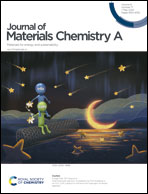Identification of functionality of heteroatoms in boron, nitrogen and fluorine ternary-doped carbon as a robust electrocatalyst for nitrogen reduction reaction powered by rechargeable zinc–air batteries†
Abstract
Efficient nitrogen reduction reaction (NRR) catalysis relies on the active sites of the electrocatalyst being capable of adsorption of hydrogen ions and nitrogen molecules. As has been well reported, nitrogen-doped carbons are efficient electrocatalysts for the hydrogen evolution reaction (HER) due to their ability to adsorb hydrogen ions, to combine them and to release H2. The introduction of other heteroatoms to disturb the successive HER active sites in nitrogen-doped carbon, and to offer binding sites for N2, is beneficial for efficiently catalyzing the NRR. Here, we rationally synthesize boron, nitrogen and fluorine ternary-doped carbon (BNFC) from the carbonization of cigarette butts saturated with the ionic liquid 1-butyl-3-methylimidazolium tetrafluoroborate (C8H15N2BF4). Nitrogen atoms in BNFC are capable of adsorption of hydrogen ions, and the adjacent B or F heteroatoms offer Lewis acid sites for chemisorption of N2; in the case of this synergistic catalysis, a boosted electrocatalytic activity toward the NRR with an NH3 yield rate of 41 μgNH3 h−1 mgcat.−1 and a faradaic efficiency as high as 14% at −0.4 V vs. reversible hydrogen electrode (RHE) are recorded for BNFC in 0.05 M H2SO4 electrolyte. Moreover, a comparably high NH3 yield rate (39 μgNH3 h−1 mgcat.−1) and faradaic efficiency (16%) at −0.4 V vs. RHE are also recorded in 0.1 M NaOH electrolyte due to the capability of water dissociation and adsorption of generated hydrogen ions by the nitrogen atoms in BNFC. In addition, due to the modulated electronic structure of the carbon atoms by means of heteroatom doping, BNFC also exhibits a Pt-like oxygen reduction reaction (ORR) activity with a half-wave potential of 836 mV vs. RHE and superior oxygen evolution reaction (OER) demanding a low overpotential of 313 mV to achieve 10 mA cm−2. As a consequence, the assembled rechargeable zinc–air batteries (ZABs) perform at a 1.8-fold higher power density than commercial Pt/C–IrO2 and sustain this for 2300 cycles with minimal degradation in performance. The battery performance of all-solid-sate ZABs also outperforms that of commercial Pt/C–IrO2 systems and can power the OER–NRR coupled device to electrochemically generate NH3.



 Please wait while we load your content...
Please wait while we load your content...